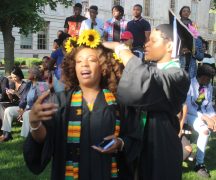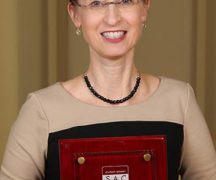By DAVID DUPONT
BG Independent News
As the Bowling Green State University Board of Trustees acted on increasing the cost of housing and meals, they were being assured that the university was still a good deal compared to most of its sister institutions.
Trustees Friday approved housing rate will increase an average of 2.1 percent. The basic double occupancy room rate will go up 2.4 percent to $2,790, up $65 per semester. The cost of rooms will range from there up to $4,030 for what’s described as “a super single.”
Meal plans will increase an average of 3 percent. The price of plans for resident students would range from $1,669 to $2,156, with increases of $49 to $63, per semester. The commuter meal plan will be $315, a 2.9-percent increase.
Sheri Stoll, the vice president for administration and finance, presented a chart that showed BGSU has second lowest cost in the state for room and board. “We believe our students continue to be very price sensitive,” she said. “We have worked very, very hard to keep a tight lid on room and board fees.”
She also noted that the parlor fee for fraternities and sororities will not go up. The fee is assessed annually to each Greek organization, which determines how to pass it along to members. The fee is to cover the costs of common spaces that are used both by those residing in Greek housing and those members who live elsewhere but still use the common spaces.
Stoll said dorm occupancy tops 90 percent, but that figure includes the remaining housing in the Harshman Quad, which will close at the end of the semester. Occupancy in the newest dorms is approaching 99 percent.
In explaining the increases in the meal plan, Stoll noted that there have been no increases in three of the last six years. But increases in the cost of food and labor, the biggest drivers for how much it costs to provide the service, have gone up necessitating the increase.
The university sold about 12,000 mandatory plans to student living on campus. Stoll said the 850 meal plans sold to those not required to buy one is a testament to the quality and value of the product supplied by Chartwells, the university’s contractor for food service.
The trustees also approved a long list of changes to special course fees. These are charges related to particular expenses for specific courses.
Background information provided to the trustees explained: “Every semester, the University delivers instructional courses to students which require the use of special materials, laboratory supplies or ‘consumables,’ unique software, or significant access or processing time on specialized equipment.”
Stoll said the departments and administration continually monitor these fees, and the administration says “no, no, no” when increases are proposed until the increases are absolutely necessary.
The list includes a new fee for forensic science majors. Also on the list is a $295 fee, an increase of $220, for an introduction to carving course in the School of Art. Stoll explained the fee hasn’t changed since 2001 and was needed because more stone had to be purchased and then transported to campus.
Fees of $125 and $200 have been added to internships in teaching because the state no longer provides funding. Changes in FAA requirements were cited in board documents for increases in the fees for aviation students.
A number of fees were eliminated because the courses have been moved online.
Trustee Richard Ross voted against the special fee increases. He explained after the meeting that he understood that the proposed state budget forbid fee increases.
The trustees also approved the issuance of bonds not to exceed $85 million to purchase the Falcon Heights and Centennial dorms from Centennial Falcon Properties, a non-profit corporation that was set up the finance their construction.
Stoll said the university was taking over ownership earlier than expected because of favorable market conditions.
The acquisition means that Centennial Falcon Properties will cease to exist.
The construction debt is paid for by revenue generated by what students pay for housing.





